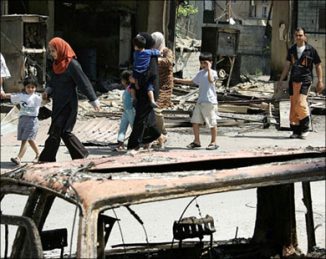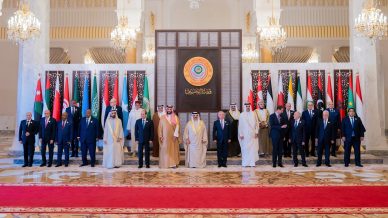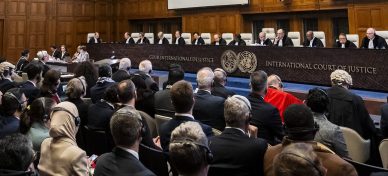The excavations before the Israeli occupation in 1967
During the period 1867-1870 a British team called “The British Fund to Explore the Archaeology of Palestine” led by Colonel Warren did some excavations that were concentrated on the Holy Shrine where they found some water wells connected to the Jeahon Spring. The team made vertical excavations and dug a horizontal tunnel around the eastern western and southern walls of the Holy Shrine in order to examine the stones which were believed to be Herodite. However one such tunnel located between Bab Al:selseleh and Al:qattaneen which is vertical to the western wall to connect Qaitby Sbeel at a length of 25 metres and a width of 6 metres did not realize their hopes. The results were presented by Warren in his books “Exploring Jerusalem” printed in 1871 and “Documentation of Jerusalem” printed in 1884. The Patriarch Vincent carried out some excavations near Jeahon Spring where he discovered porches caves cut into the rock and pottery belonging to the 3rd century BC. He concluded that the southwest hill was the original site of Jerusalem and Jeahon Spring played a significant role in developing the area. Some excavations were carried out later by the German General Conrad Chek who imagined and drew Al Haykal. This was described by Professor Mazar the president of the Hebraic University in 1975 as a legend. The most important excavations done by Chek were the canal that connects Al:majakia School with the Roman rocky ponds in the Zion nuns convent at a length of 80 metres and a width of 1.5 metres. The Israeli department of archaeology dated this canal to 152-37 BC as the main water resource for Jerusalem and the Holy Shrine. During the British Mandate several archaeology institutions were founded such as the American School for Oriental Archaeology led by Oulbrite and the British Fund to Explore the Archaeology of Palestine which carried out several excavations most notably during the period 1923-1928 around Jerusalem. The archaeologists spent a lot of time trying to comprehend those excavations and their relation to Jerusalem. During the Jordanian reign (1948-1967) the British archaeologist Cathie Kenyon the head of the British Archaeology School came to the area and carried out a lot of excavations in 1961 especially in the eastern part of Jerusalem where she studied everything about the city. She then presented this in her book “Jerusalem: 3000-year Excavations” in 1967. Interestingly she did not support the Israeli claims surrounding Al Aqsa Mosque.
The Israeli Excavations after 1967
These excavations began late in 1967 and they are still continuing up to the present despite the United Nations resolutions to cease such activity.
1. The excavations south of Al Aqsa: These excavations began late in 1967 and were completed in 1969 at a length of 70 metres under the southern wall behind Al Aqsa the Women’s Mosque the Islamic Museum and Al:fakhria Minaret at a depth of 14 metres which threatened the integrity of both the southern wall and Al Aqsa Mosque. These excavations were financed by the Hebraic University represented by its president Professor Mazar and his deputy Professor Meir Ben Dov both of whom presented the first report in 1969. They discovered Islamic Umayyad ruins belonging to the period 660-750 CE (Common Era) as well as Byzantine and Roman ruins. He explained this in his book published in 1975 showing pictures of those ruins. However he insisted that Al Haykal is under Al Aqsa and it is accessible through the west door at Robinson Arch whereas Professor Koffman said it is accessible through the eastern Golden door.
2. The excavations west of Al Aqsa Mosque: These excavations were carried out in 1969 at a length of 80 metres and began where the first part had been finished at Bab Al:maghrbeh under a group of Islamic buildings belonging to Al:fakhria Corner/Al:shaf’ee Centre which cracked and was removed by Israeli bulldozers on 14 June 1969. Meir Ben Dov says “I discovered three Umayyad palaces-two of which are identical”. Howver B. Mazar says in his book “There is not any evidence about Al Haykal except what is said by the Jewish historian Josephus Flavius who dated the Jewish era as in Al:meshna the Bible and the Talmud but those books are not objective because they expressed the Jewish hopes dreams and aspirations without any documentation” which contradicts the Jewish claims and assumptions about Al Haykal.
3. The excavations southeast of Al Aqsa: These excavations began in 1973 and continued until 1974 at a length of 80 metres eastward penetrating the southern wall in July of 1974 and continued to the lower porches of Al Aqsa at four locations:
(a) Under Al:mehrab at a length of 20 metres.
(b) Under Omar’s Mosque southeast of Al Aqsa.
(c) Under the three porches located under Al Aqsa Mosque.
(d) Under the southeastern porches of Al Aqsa Mosque.
The depth of these excavations was 13 metres which threatened to collapse the southern wall because the wall itself is rather old and the supporting earth had been removed. In addition the noise made by the Israeli supersonic jet fighters flying over the Holy Shrine are also a threat to the integrity of the wall.
4. Removing Al:maghrbeh Quarters: This area was destroyed and removed by Israeli bulldozers on 11 July 1967. The area is adjacent to Al Aqsa and it is a stronghold which separates the Holy Shrine from the Jewish Quarters. It is also close to Al Aqsa wall. There were two mosques and 135 houses in this area that had been founded by King Al:afdal in 589-592 CE who gave this area to the Moors (Al:magharbeh) in Jerusalem which is a part of his kingdom (see Al:uns Al:jaleel ch. 2 p. 48). Presently the area is a large parking lot for tourists and Jews to enter the western tunnel.
5. The excavations of the western tunnel: These excavations began in 1970 and were stopped in 1974 then resumed in 1975 and continued up until 1988 despite UNESCO resolutions. They ran under the legal court (the oldest building in Jerusalem) under five doors of the Holy Shrine (namely Bab Al:selseleh Bab Al:mat-hareh Bab Al:qattaneen Bab Al:hadeed and Bab Ala’edeen Al:bseiry [the Islamic Council]) under some ancient places (including four mosques) under Qaitby minaret under Sou Al:qattaneen and under some old schools and houses belonging to 3000 Arabs. The depth was 11-14 metres underground at a length of 450 metres and a height of 2.5 metres which caused some cracks in some of the buildings including the Ottoman Mosque Rebat Kurd Al:jawharia School Al:manjakia School (the Islamic Council) Al:wafaia Corner Beit Al:shehaby and some Umayyad and Byzantine ruins (walls and stone arches). In March of 1987 the Israelis announced that they had discovered the canal which was first discovered by General Conrad Chek in the 19th century at a length of 80 metres. They not only connected the canal with the tunnel but they also carried out more excavations under the protection of the Israeli army on 7 June 1988 at the junction of Bab Al:magharbeh way and Al:mujahideen way also known as the Passion way (Via Delaroza) using bulldozers to make a vertical hole leading to the Roman Canal and the tunnel. This was objected to by the Arabs so it was stopped and the hole was closed. The goal of this was to ventilate the canal and the tunnel to set up a checkpoint with guards and to reach the Roman ponds. Although the hole had been closed both the Israeli Minister of Religions Zovlon Hamar and the Mayor of Jerusalem Teddy Kolic said that the excavations would be resumed soon. This showed that Israelis were ignorant to all human ideals because they really resumed the excavations to open another door for the tunnel during Rabin’s term in office. However they were prevented by the Arabs. Finally the Israelis were able to resume their activity in this regard because they were supported by Netanyahu when they opened the door through Al:mujahideen way on 24 September owing to the following:
(a) It was carried out under the orders of the Prime Minister.
(b) It was carried out at night under the protection of the army.
(c) Arabs were prevented from entering the area.
(d) They used heavy bulldozers to finish as soon as possible.
They did this under the pretext of ventilating and lighting the tunnel to make prayers easier and to encourage the Jews to visit Jerusalem and pray in the tunnel which had become a Jewish synagogue all of which threatens the integrity of Al Aqsa. Netanyahu announced that the tunnel was old and the Israelis had just reopened it. However this was condemned by the Arab States because when the tunnel was first discovered by Conrad Chek its length was only 80 metres yet the Israelis increased the length to 450 metres extended from Bab Al:magharbeh to Al:ghawanmeh. Jordan protested and as a result UNESCO decided to put a stop to it but Israel did ignored the request. The technical advisor of the chief of UNESCO reported that Israel had used chemicals to break the rocks which threatens to collapse the Islamic buildings and this refuted the fact that this tunnel had been an old one.
6. Re-opening Warren’s excavations: The Israeli forces re-opened the tunnel which had been discovered by Colonel Warren in 1867 on the 12th anniversary of the burning of Al Aqsa on 21 August 1981. However the Arabs stopped this and the department of Al:awqaf blocked it with cement on 29 August which caused some cracks in the west porch over the tunnel.
7. Bab Al:amoud excavations: The Israeli Department of Archaeology carried out some excavations under Bab Al:amoud in 1975 to find the old wall at a depth of 5 metres in order to connect the door with the front yard by a pedestrian overpass.
8. Bab Al:usoud and Al:asbat excavations: The area between Bab Al:usoud and Bab Al:asbat had been used as a distribution area by UNRWA after 1967. The Israeli forces decided to carry out some excavations under a pretext of being a Jewish pool despite the objection of Al:awqaf. The excavations were completed in 1986 without finding any Israeli ruins then a stone theatre and a wall to separate the area from Al:mujahideen way were built according to the Israeli charts.
9. Bab Al:khaleel Castle excavations: These excavations were carried out near Al:qasla’the police centre in 1975 without finding any Israeli ruins.
10. The Prophet David’s area excavations: These excavations were done to examine the results of the excavations carried out by the British K. Jones in 1940 which was called David’s Tower.
11. Sharaf Quarters excavations: This area is a residential one belonging to the Sharaf family. Some houses had been rented for Jews since the time of the British Mandate but only 4% of the houses were owned by Jews. This area was destroyed in 1948 and the people were consequently deported. It remained as it is during the Jordanian reign because the municipality could not get a loan to re-build it. Israelis claim that it belongs to them so a team led by Nehman Avigad did some excavations but nothing was found except a rocky layer which he claimed belonged to the King Hezekiah. Afterwards the Jerusalem municipality built 600 houses overlooking the Holy Shrine.
12. Modern excavations: Presently several excavations are being carried out one of them begins from Bab Al:ghawanmeh toward the Dome of The Rock passing through two water wells to reach the foundation of the Dome of the Rock. There is another completed one toward Al Aqsa. The Israeli forces announced that the excavations will continue under the old city to find out about Al Haykal under the pretext of archaeological excavations which have not revealed anything to prove the Jewish claims. The main reason for these excavations is to destroy the Islamic Holy Places and Judaize the city. The city hill still has its Islamic character despite the Israeli procedures and confiscation of the land. The people of the city have been standing fast against this but they need more real Arab support through actions not through speeches and orations.












